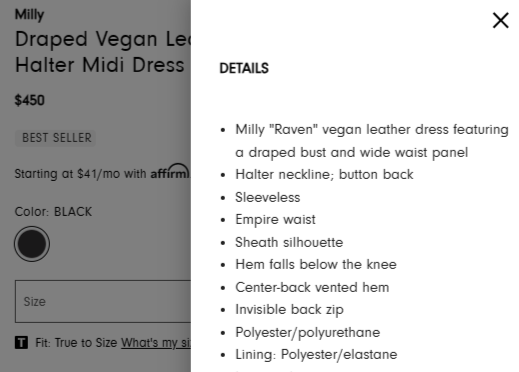Vegan leather is often touted as a compassionate alternative to traditional leather. Advertisements are filled with buzzwords like “eco-friendly,” “sustainable,” and “green.”
But is vegan leather truly as environmentally benign as we’ve been led to believe?
Let’s embark on a journey through the production of vegan leather and demystify the greenwashing that surrounds it.
Vegan Leather: What is it made of?
First, we need to clarify and understand what vegan leather is.
Predominantly, vegan leather is made using polyvinyl chloride (PVC) or polyurethane (PU), both of which are plastic-based materials. So, yes, “vegan” leather is just plastic!
Here’s a step-by-step look into how most vegan leathers are made:
- Extraction of Raw Materials: PVC and PU originate from fossil fuels, such as petroleum. Extracting these raw materials leads to environmental degradation and contributes significantly to greenhouse gas emissions.
- Polymerization: The raw materials undergo a process to create polymers, which are the primary components of plastics.
- Coating: These polymers are then coated onto a fabric backing to give the texture and feel of leather.
- Addition of Plasticizers and Other Chemicals: To make the material pliable and leather-like, chemicals called plasticizers are added. Some of these chemicals, particularly phthalates in PVC, can be toxic and harmful to both the environment and human health.
- Final Processing: The material is then treated to give it the desired color and texture. This process might involve more chemicals and dyes.
Greenwashing Vegan Leather
Greenwashing refers to the act of conveying a false impression or providing misleading information about the environmental benefits of a product. We’ve been through this before in the fashion industry and there’s always the mighty greenwashing of the ‘eco-friendly’ bamboo.
In the context of vegan leather:
- Misuse of “Eco-friendly” Labels: Since vegan leather doesn’t use animal skins, it’s assumed to be environmentally friendly. However, as discussed, its production relies heavily on petrochemicals.
- Overemphasis on Cruelty-Free: While it’s true that vegan leather doesn’t harm animals directly, this emphasis overshadows the significant environmental damages incurred during production.
- Lack of Biodegradability: Unlike genuine leather, which can decompose within 50 years under the right conditions, plastic-based vegan leather can take hundreds to thousands of years to break down, contributing to the long-term environmental problem of plastic pollution.


Vegan Leather vs. Real Leather: An Environmental Perspective
- Carbon Emissions: Both vegan leather and real leather have carbon footprints. However, the extraction, refining, and processing of petrochemicals for vegan leather often result in higher greenhouse gas emissions compared to the raising and processing of animals for traditional leather.
- Durability: Genuine leather is known for its long-lasting nature. Vegan leather, on the other hand, tends to degrade and lose its appeal faster. This means consumers might replace vegan leather items more frequently, leading to more waste and consumption in the long run.
- Chemical Use: The tanning process for real leather can use harmful chemicals like chromium. But as discussed, vegan leather also relies on potentially hazardous substances. It’s crucial to note that there are eco-friendlier tanning methods for genuine leather, such as vegetable tanning.
- Water Usage: Animal agriculture, and consequently leather production, is water intensive. However, the water pollution resulting from the chemicals used in vegan leather production is frequently more challenging to treat and manage.
The Economic Impact of the Rise of Vegan Leather
The surge in popularity of vegan leather isn’t merely an environmental or ethical narrative; it’s also an economic story of transformation, opportunity, and disruption. As with any industry undergoing rapid change, there are both winners and losers. Let’s delve deeper into the economic implications of the ascendancy of vegan leather.
Traditional Leather and Livelihoods
For centuries, leather has been a fundamental material for a plethora of products — from shoes and belts to furniture and car interiors. Its production has fostered entire industries, from animal farming to tanneries, and provided employment to millions globally.
Local Communities
In many regions, especially in developing countries, small-scale traditional leather production is more than just an industry; it’s a cultural and ancestral practice.
Communities in countries like India, Bangladesh, and Ethiopia rely heavily on leather production. For these craftsmen, leather isn’t just a material; it’s a legacy passed down through generations.

Tanneries
Tanneries, which are integral to the leather processing chain, have historically been major employers. Many tanneries, especially in developing countries, operate with minimal mechanization, relying on manual labor, and thus creating numerous jobs.
The Rise of Vegan Leather: Disruption and Opportunities
The rise of vegan leather has led to both disruption in traditional markets and the emergence of new opportunities.
- Shift in Job Market: As demand for traditional leather declines, tanneries and associated businesses might witness job losses. Conversely, vegan leather manufacturing, especially when based on petrochemicals, tends to be more mechanized, potentially leading to fewer manual jobs per unit of output.
- New Materials, New Markets: On the brighter side, the development of alternative materials like Piñatex (from pineapples) or mycelium leather (from mushrooms) is fostering new industries. These innovative materials aren’t just creating jobs in production but also in research, development, and marketing. For example, farming waste products like pineapple leaves for Piñatex can offer farmers an additional revenue stream.
- Economic Decentralization: While traditional leather production has been concentrated in specific regions, the rise of vegan leather, especially those from plant-based sources, allows for more decentralized production. Different countries and regions can leverage their unique agricultural products or innovations to join the market.
- Economic Rejuvenation in Traditional Hubs: Interestingly, some traditional leather hubs are catching onto the vegan trend. Recognizing the changing winds, they’re starting to diversify by producing vegan leather or blending both vegan and traditional leather, ensuring their economic relevance.
The Consumer Economic Impact
Vegan leather’s rise also impacts consumer economics. Historically, genuine leather products were often more expensive due to the intensive production process.
Vegan leather, particularly those made from PVC or PU, can be more affordable, thereby democratizing access to “leather-like” products.
However, high-quality, and sustainable vegan leathers, like those from mushrooms or pineapples, can command premium prices, reflecting their eco-friendliness and innovation.
In Closing…
More To Discover
- Better Vegan Leather Alternatives: Pineapples and Mushrooms May Change Everything
- Sheep vs Cow Leather: Comparison of Sheepskin or Cowhide
- Self-Healing Leather Alternative from Fungi: Could It Be Mass-Produced for Sustainability?
- The Hidden Giants Behind Vegan Brands Are The Meat And Dairy Industry Heavyweights
The discussion surrounding vegan leather’s environmental impact isn’t black and white.
While genuine leather has its environmental challenges, vegan leather isn’t the eco-panacea it’s often portrayed to be. As consumers, we must be informed (and be willing to change our point of view based on the facts) and make choices based on a holistic understanding rather than catchy marketing terms.
As the adage goes, “There’s no such thing as a free lunch”—and in the case of leather, neither vegan nor traditional versions come without an environmental cost.



















